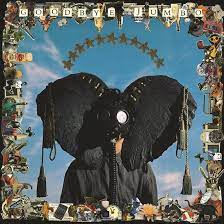WORLD PARTY : GOODBYE JUMBO
- Is It Too Late?
- Way Down Now
- When The Rainbow Comes
- Put The Message In The Box
- Ain't Gonna Come Till I'm Ready
- And I Fell Back Alone
- Take It Up
- God On My Side
- Show Me To The Top
- Love Street
- Sweet Soul Dream (With Sinéad O'Connor)
- Thank You World
Label : Ensign Records
Release Date : April 24, 1990
Length : 53:29
Review (AllMusic) : This excellent follow-up album from World Party is much tighter than the debut. Dealing with issues from the environment ("Take It Up," "Put the Message in the Box") to relationship woes ("And I Fell Back Alone"), these tracks manage to maintain a hopeful, positive mood without becoming trivial. In these songs, Wallinger has developed his own distinct style. A great album, worth checking out just for the uptempo groove of "Way Down Now."
Review (Wikipedia) : Goodbye Jumbo is the second studio album by British alternative rock band World Party, released on 24 April 1990 on Ensign Records. The album received generally positive reviews from critics and peaked at No. 73 on the US Billboard 200 and No. 36 on the UK Albums Chart. "Way Down Now", the album's lead single, spent five weeks at number one on the Billboard Alternative Songs chart, and follow-up single "Put the Message in the Box" reached No. 8. In a contemporary review for the Chicago Tribune, Greg Kot noted heavy influence from The Beatles in the album's "sense of pop and studio craft" and wrote that the biting humor and irony expressed in Wallinger's lyrics was balanced out by "memorable melodies and moments", calling all the album's songs "worth savoring." Chris Willman of the Los Angeles Times felt that his "Lennonisms sound somehow endemic, not affected" and the wide range of musical influences on Goodbye Jumbo did not constitute "petty theft", stating that the album "comes together marvelously." Don McLeese of Rolling Stone wrote that Goodbye Jumbo "displays an ambition as broad as the emotional range of its music" and that while Wallinger's "missionary zeal occasionally belabors his messages", the album's music is "sufficiently vital to overpower resistance". Spin's Jon Young dubbed it as a "winning opus". One detractor was Robert Christgau of The Village Voice, who assigned the album a "dud" rating, indicating "a bad record whose details rarely merit further thought". Goodbye Jumbo was named the fifteenth best album of 1990 in The Village Voice's year-end Pazz & Jop critics' poll. It was named as Album of the Year by Q in 1990, with the album also receiving a nomination for a Grammy Award for Best Alternative Music Album the same year. In 2000, Q placed it at number 94 in its list of the 100 Greatest British Albums Ever. In 2000 it was voted number 474 in Colin Larkin's All Time Top 1000 Albums.
Review (DaMusic) : Het is het eerste dat je ziet, als je een plaat koopt: de hoes. Of - in het Engels klinkt het altijd iets gewichtiger - het artwork. Te vaak gaan we voorbij aan de aantrekkingskracht die een album- of singlehoes kan hebben. Vraag maar aan New Order die in Peter Saville een geknipt kunstenaar vonden en daarmee op zich al deden uitkijken naar de volgende release van de band. Heeft u dat ook? Dat, als je met de hoofdtelefoon een plaat aan het beluisteren bent, dat je de tijd neemt om de hoes ervan te bekijken? Dan is het een genot om een plaat als deze van World Party voor de kiezen te krijgen. Niet alleen het centrale beeld is intrigerend, je hebt ook nog eens alle prullaria aan de zijkant, waar je jezelf in kan verliezen. Of zoals Karl Wallinger het zelf zegt: "The cover is like a chocolate box. You want to pick all the things up and play with them, taste everything. You want to pick up the vitamin bottle and take them all". Het ontwerp van dit artwork ontspruitte uit het hoofd van frontman van de band Karl Wallinger, toen hij een foto zag van Tim Buckley met een gasmasker in de smog van Los Angeles (op de hoes van 'Greetings from L.A.'). Dat u het thema van de songs en dus ook van de hoes moet gaan zoeken in de bedreiging van het milieu. De oren werden gemaakt door Edward Durdey. En ook daarin zitten nogal wat symbolen verstopt. Er zijn de gouden containertjes, waarin dromen of de ziel werd bewaard; er zijn de gordijnkoorden aan de uiteindes, een idee dat Durdey had meegebracht van een reis uit India, waar hij dit had gezien bij getrainde dieren. En dan is er nog de positie van de oren, hetgeen betekent dat een olifant bedreigd wordt en mogelijk kan aanvallen, een beetje zoals het milieu. Het gasmasker werd zo ook meteen de slurf van de olifant en gaf Wallinger meteen de gelegenheid om zijn punt te maken: "It's also a symbol of green politics because we're all aware of the environment. And on the cover, because I've got the mask on, I'm in danger". De foto werd gemaakt in de studio met een geschilderde, helblauwe luchta als achtergrond. De wolken geven het idee van perspectief. De olifantenoren werden op een stelling geplaatst, waarna Wallinger zich ertussen moest wringen. Het kader rond de centrale foto was een idee van Stephanie Nash van de Michael Nash Foundation. De objecten zijn niet willekeurig, maar stellen de songs van het album voor. Wallinger voegde er later nog een aantal persoonlijke stukken aan toe. De afbeeldingen komen uit verschillende catalogi, en uiteindelijk werd de hoes later nog opnieuw afgedrukt, omdat een aantal van de zaken verwijderd moesten worden.
